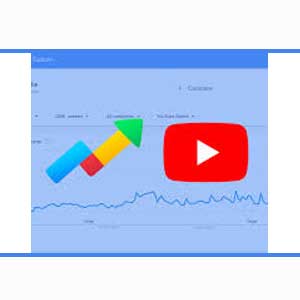Google Patterns can deliver a wealth of information that can help drive strategies for keywords and content.
You will learn a couple of ways to use Google Trends in this article to help gain insights into YouTube and your video content strategy.
What is reflected by Google Trends Data?

There is a fair deal of uncertainty about what knowledge inside Google Trends is actually portrayed.
For a particular query, Google Trends does not reflect the real search rate, but rather the relative popularity of a search word. In other words, relative popularity is the ratio of a query’s search volume to the sum of all possible queries’ search volumes.
Understanding data from Google Trends & the YouTube Algorithm
It is important to understand in order to use Google Trends successfully to generate video content ideas:
– How Google Trends displays data.
– The YouTube algorithm.
Google Trends
As described above, with Google Trends, a common misconception is that the tool reports on the search volume of different keyword terms and topics. In fact, to make comparisons between terms more simplistic, Google Trends reports on normalized search data.
The data is standardised in the following way, according to Google:
– The overall geography research and the time span of each data point is separated by comparing relative popularity.
– The resulting numbers are then scaled to a range of 0 to 100 based on the proportion or relative relation of a subject to all searches on all sorts of different topics.
– There are not necessarily the same total search volumes in different regions that display the same amount of search interest for a particular word.
So, in essence, Google Trends shows interest from around the world in a specific subject.
YouTube Algorithm
To help optimise content for YouTube, do you want to use Google Trends? Then it is important to grasp some of Google’s algorithm’s inner workings.
The algorithm of Youtube focusing strongly on the output of images. This encompasses:
– Click-through rates.
– Average watch time
– Number of likes, dislikes, comments, and shares.
– How popular a video is (velocity a.k.a., rate of growth).
– How new a video is (new videos often get preference).
– Frequency of often a channel uploads new videos.
– User session on the YouTube platform.
How to use your video marketing plan with Google trends
1. Using Categories of Google Trends
To help see topics that fall in line with what your channel covers, you can use Google Trends’ category feature.

You will see similar topics that might still apply, even though your channel is not explicitly in line with any of these categories.
For example, you can see that there are several overlapping topics by looking at the “food & drink” category. Unsurprisingly, at this stage, COVID-19.

This is a great way to look at issues that are trending during your quest and find overlaps that might be important to your channel’s video material.
You can click on each of them to see related articles that can provide more information into the specifics if you want to see more granular details into what exactly is trending inside each of these subjects.
2. See different kinds of search
Another realistic feature of Google Trends is that trends in different search types can be found.
Standard web search and YouTube search can also be used to access them.
Looking at the regular Google search engine is useful to generate ideas about video content, but by finding out what is actually going on inside YouTube search you can get even more insights.
You will note that there are some similarities and differences that can allow you to make specific video content better.

YouTube Search

Web Search

Some similarities and discrepancies between web search and search on YouTube can be seen.
It helps to prioritise your content development to get an even more laser-focused view on what is trending in YouTube search, and not just search in general.
3. Analyze Seasonal Trends
Seasonal patterns are another thing to remember when looking at Google Trends for video content ideas.
Continue to read below
By defining these, you can plan and prioritise your content development.
Obviously, seasonality will differ by subject. We know certain patterns are undoubtedly seasonal and can therefore prioritise them around them.
For instance , take the “eggnog recipe”:

Web Search

YouTube Search

This is also especially useful, as the YouTube algorithm can prioritise trends and recent videos.
This can greatly help to capitalise on that feature of the YouTube algorithm if you can recognise a seasonal subject, or more of a subject that is trending due to something situational.
This will get the video in front of more eyeballs afterwards.
4. Timely Keyword Goals Find
For keyword analysis, Google Trends can be especially helpful.
Although Google Trends does not report on search volume, as we noted earlier, it does report on the aggregate popularity of specific topics.
Also, because of the trendy data, Google Trends will help give you more insight into which general keywords or subject clusters to target.
You can easily see which subjects over time are trending upward in popularity and downward.
Downward: “At home workouts”

Upward: “Early voting by state”

In addition, to help build out optimal content sub-topics, you should look at the relevant topics are these timely topics.

5. Observe the Topical Patterns by Area
Google Trends may help recognise topics of content that differ in popularity according to state or country.
This can help guide strategies for hyper-local content for local optimization purposes.
In these places, you can create useful content directly targeted at people:

To see any similarities or differences, you can also dig down deeper and use a position reference instrument.
Looking at this will assist you in prioritising content by region.


If you have found even a small or significant difference in the timeliness of a subject by zone, the content timeline for those areas can be prioritised.
Conclusion
Google Trends can be very helpful , particularly in a year where trending topics and traditional seasonality look different for many companies, for keyword analysis , content calendar planning, and a number of other organic tasks and projects (as well as paid ones).


